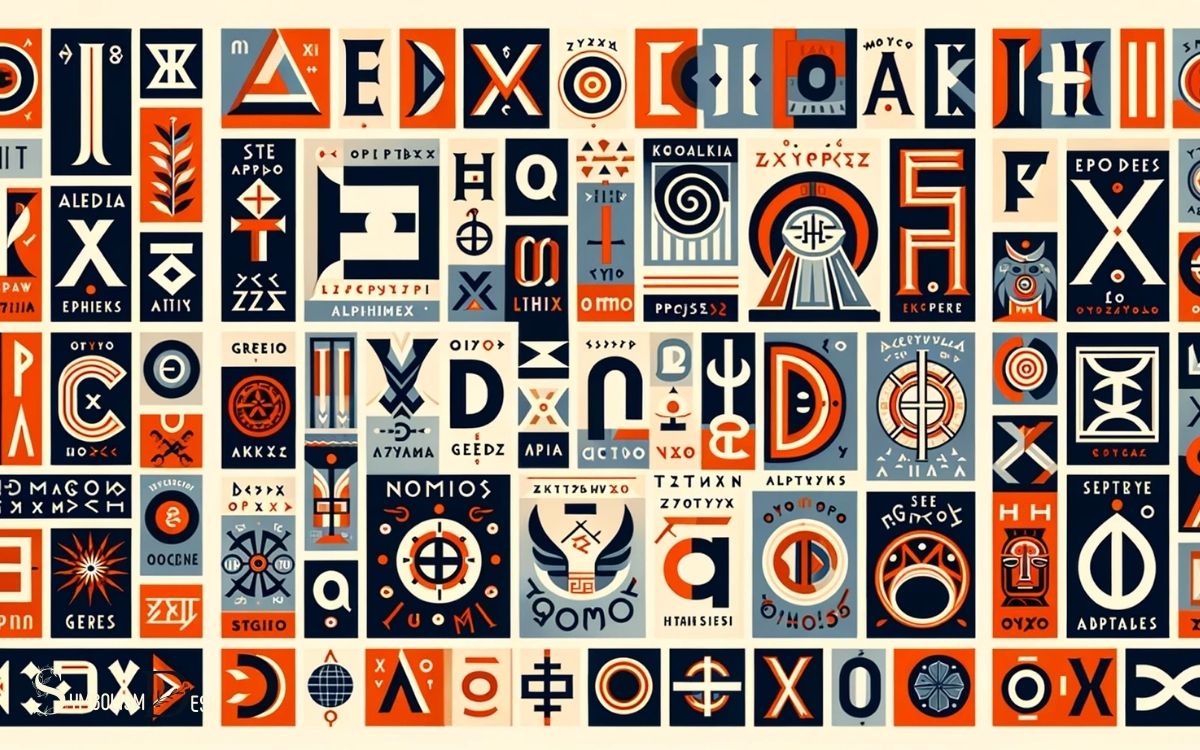Greek Alphabet Symbols and Names: Explain!
The Greek alphabet is a set of characters that has been used to write the Greek language since the late 9th or early 8th century BC. It is the first and oldest alphabet in the narrow sense that it notes each vowel and consonant with a separate symbol.
The Greek alphabet has been the basis for writing numerous other languages and plays a significant role in mathematics, science, and other fields.
Here is a list of the Greek alphabet symbols along with their names:
- Alpha (Α, α)
- Beta (Β, β)
- Gamma (Γ, γ)
- Delta (Δ, δ)
- Epsilon (Ε, ε)
- Zeta (Ζ, ζ)
- Eta (Η, η)
- Theta (Θ, θ)
- Iota (Ι, ι)
- Kappa (Κ, κ)
- Lambda (Λ, λ)
- Mu (Μ, μ)
- Nu (Ν, ν)
- Xi (Ξ, ξ)
- Omicron (Ο, ο)
- Pi (Π, π)
- Rho (Ρ, ρ)
- Sigma (Σ, σ/ς) – Note that sigma has a special final form (ς) when used at the end of a word.
- Tau (Τ, τ)
- Upsilon (Υ, υ)
- Phi (Φ, φ)
- Chi (Χ, χ)
- Psi (Ψ, ψ)
- Omega (Ω, ω)

Key Takeaway
Origins of the Greek Alphabet
The origins of the Greek alphabet can be traced back to the Phoenician alphabet, with the Greeks adapting and modifying many of its symbols and sounds to suit their own language and writing needs.
This adaptation process is believed to have taken place around the 8th century BCE. The Greek alphabet was the first alphabet to include vowels, which made it more suitable for transcribing the Greek language.
It consisted of 24 letters, and some of these letters were directly taken from the Phoenician alphabet, while others were modified or newly created.
The Greek alphabet played a significant role in the development of Western alphabets and writing systems, as it became the foundation for the Latin, Cyrillic, and many other alphabets used worldwide today.
Its historical significance and influence on written communication are undeniable.
Development and Evolution of Symbols
Development and evolution of Greek alphabet symbols occurred through a process of adaptation and modification from the Phoenician alphabet around the 8th century BCE.
The early Greek alphabet consisted of 24 letters, many of which were directly derived from the Phoenician symbols. Over time, the Greeks adjusted and refined these characters to suit their language and writing style.
The evolution of these symbols reflects the cultural exchange and influence between ancient civilizations. As the Greek city-states grew in prominence, the alphabet underwent further changes, leading to the classical Greek alphabet that is known today.
These developments in the Greek alphabet laid the foundation for the written communication and record-keeping of ancient Greece, and they continue to influence modern alphabets.
Understanding the evolution of these symbols provides insight into the historical context of ancient Greek culture and language.
Significance in Ancient Greek Culture
In the context of ancient Greek culture, the Greek alphabet symbols held significant importance and served as fundamental tools for communication and expression.
The alphabet not only enabled the recording of language but also played a pivotal role in the development of art, literature, science, and philosophy.
Each symbol had both a phonetic and numerical value, contributing to its versatility and widespread use in various aspects of daily life.
The alphabet’s significance was further underscored by its association with religious and mystical beliefs, where certain letters were attributed symbolic and metaphysical meanings.
Moreover, the Greek alphabet’s influence extended beyond Greece, as it became the basis for the Latin, Cyrillic, and many other writing systems, leaving an enduring legacy on global communication and culture.
Influence on Modern Language and Science
The Greek alphabet has had a profound impact on modern language and science. Many words in English and other languages have Greek roots, and scientific terminology often derives from Greek.
Understanding the influence of the Greek alphabet on these aspects of modern society provides insight into the enduring legacy of this ancient writing system.
Language Evolution From Greek
Greek language’s profound influence on modern language and science is evident in the extensive vocabulary and terminology derived from its rich linguistic legacy.
The evolution of Greek has left an indelible mark on various languages and scientific fields, demonstrating its enduring impact.
Consider the following points:
- Vocabulary Influence
- Many English words have Greek roots, such as “telephone” (tele- “far” + phone “voice”) and “biology” (bio- “life” + -logy “study of”).
- Scientific terms like “geology” (geo- “earth” + -logy “study of”) and “psychology” (psycho- “mind, soul” + -logy “study of”) have direct Greek origins, showcasing its influence on specialized fields.
The Greek language continues to shape and enrich modern language and scientific discourse, highlighting its significance in the evolution of human knowledge and communication.
Scientific Terms From Greek
The profound influence of the Greek language is evidenced by the extensive presence of scientific terms with Greek origins in modern language and specialized fields.
From astronomy to medicine, Greek has significantly shaped the terminology used in various scientific disciplines.
For instance, terms like “biology” (bios, life), “geology” (ge, earth), “psychology” (psyche, soul), and “physics” (physis, nature) all find their roots in the Greek language.
The use of Greek roots in scientific terminology allows for precision and clarity in communication, facilitating the global exchange of scientific knowledge.
This influence highlights the enduring legacy of Greek language and culture, as well as its ongoing impact on the development and understanding of modern science and technology.
Lesser-Known Characters and Their Meanings
Let’s explore the unique interpretations and meanings of lesser-known Greek alphabet characters, shedding light on their significance and relevance.
Additionally, we will uncover the obscure Greek characters that are often overlooked but hold intriguing historical and linguistic value.
This discussion aims to provide insight into the hidden gems of the Greek alphabet and their impact on language and culture.
Unique Symbol Interpretations
Exploring the lesser-known characters of the Greek alphabet provides insight into their unique symbol interpretations and meanings. Delving into these less familiar symbols reveals fascinating layers of significance and historical context. Additionally, many of these characters have connections to mythological figures, influencing their interpretations across cultures. For example, the Roman adaptation of the Greek god of the underworld, known for his stern demeanor and association with death, reflects in the phrase ‘hades’ roman name and characteristics. ‘ Understanding these characters not only enriches our grasp of the alphabet but also deepens our appreciation for the cultural narratives they encapsulate. In particular, the Greek god Poseidon symbols explained can offer a deeper understanding of his dominion over the sea and earthquakes. These symbols, often associated with power and fluidity, reveal how ancient Greeks interpreted natural phenomena through their deities. By studying these representations, we gain a clearer picture of how the Greek alphabet shaped their mythology and cultural identity. For instance, understanding the letter “Phi” not only enhances our comprehension of its phonetic value but also uncovers associations with philosophical concepts in ancient Greece. Similarly, examining the hermes roman name significance sheds light on trade, communication, and the balancing of dualities that were central to both Greek and Roman cultures. These connections between letters and their historical meanings enrich our appreciation of the alphabet’s evolution and its impact on language.
Let’s uncover some of these hidden gems:
Sampi (Ϡ):
- A symbol with a convoluted history, often associated with the numeral 900 or used as a symbol for the ancient Greek city of Stymphalos.
- Its enigmatic nature has sparked various interpretations, making it a subject of intrigue for historians and linguists alike.
Koppa (Ϙ):
- Initially representing the /k/ sound in ancient Greek, koppa’s usage evolved over time, eventually falling out of common use.
- Its enigmatic form and changing role in the Greek language offer a glimpse into the linguistic evolution of the ancient world.
Obscure Greek Characters
Delving further into the Greek alphabet, it is essential to shed light on the obscure characters that hold unique meanings and historical significance.
One such character is the stigma (Ϛ,ϛ), representing the numeral 6 in the ancient Greek numeral system.
Another is the koppa (Ϟ,ϟ), which denoted the number 90. Both characters were gradually phased out as the Greek numeral system evolved.
The sampi (Ϡ,ϡ) is yet another lesser-known character, representing the number 900. Used in ancient writings, it eventually fell out of use. These obscure characters provide insight into ancient Greek numerical systems and their evolution over time.
Understanding these characters enriches our knowledge of the historical and cultural context in which the Greek alphabet developed, offering a glimpse into the complexities of ancient communication systems.
Legacy of Greek Alphabet in Literature and Art
The legacy of the Greek alphabet in literature and art is evident through its profound influence on the development of written and visual expression.
This influence is demonstrated in various ways:
Literature
- The Greek alphabet laid the foundation for Western literature, with epic poems like Homer’s “Iliad” and “Odyssey” being composed and preserved in this script.
- Greek playwrights, such as Sophocles and Euripides, used the alphabet to document timeless tragedies and dramas that continue to inspire contemporary works.
Art
- Greek letterforms have been incorporated into visual art, from ancient pottery inscriptions to modern calligraphy and typography.
- The alphabet’s association with mathematical symbols and scientific notations has influenced the visual representation of knowledge and discovery in art.
The enduring impact of the Greek alphabet on literature and art underscores its enduring significance in human creativity and expression.
Conclusion
In the vast tapestry of human language, the Greek alphabet stands as a timeless masterpiece, its symbols weaving a rich and complex story that continues to influence our world today.
Like a hidden thread in a grand tapestry, the Greek alphabet’s legacy is woven into the fabric of literature, art, and science, reminding us of the enduring power and beauty of ancient knowledge.





